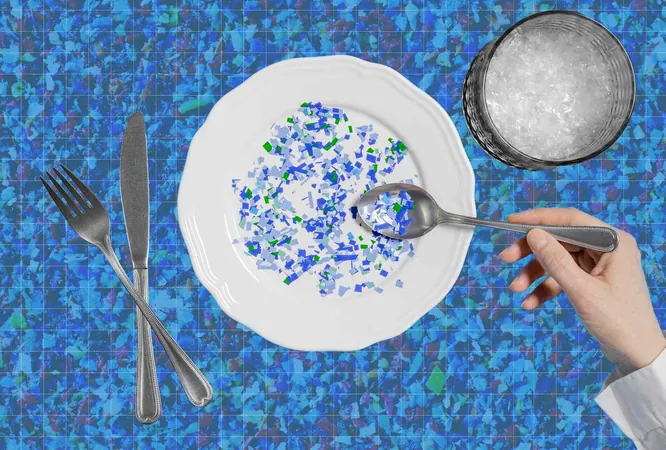
Microplastics: The Hidden Danger in Your Food—Here’s How to Fight Back!
2025-04-12
Author: Jia
Microplastics Are Everywhere—And You Might Be Eating Them!
Microplastics have infiltrated every corner of our planet—from the ocean depths to the Arctic tundra. Now, startling research from New Mexico has revealed that these tiny plastic particles have invaded even our bodies. In a shocking 2024 study, researchers found microplastics in 52 human brain autopsy samples, with concentrations significantly higher than those from 2016. Alarmingly, the microplastics are even able to cross the blood-brain barrier.
What Are Microplastics and Where Do They Come From?
Microplastics are tiny plastic debris, less than 5 millimeters in size, originating from various sources. Some of these particles are intentionally manufactured for products like cosmetics, while others are formed when larger plastic items break down—think tires, food containers, or clothes made from synthetic materials. As an FDA official stated, most plastics don’t biodegrade; they weather over time, gradually turning into microplastics that contaminate our environment and eventually our food supply.
The Shocking Reality of Microplastics in Our Food
Microplastics can sneak into our meals from two main avenues: environmental contamination and food packaging. Dr. Lili He from the University of Massachusetts Amherst notes that recent studies have shown that nearly 90% of samples from various proteins contained microplastics, with seafood leading the pack. Processed proteins like plant-based nuggets were next, followed by terrestrial meats such as chicken and beef. Unbelievably, breaded shrimp had an average of 370 microplastic particles per serving!
How Microwaving Food Could Increase Your Microplastic Intake
If you’re using plastic containers for microwaving, you might want to reconsider. A study found that polypropylene containers, commonly used for takeout, can release microplastics into your food—three times more when microwaved! This alarming fact sheds light on how our cooking methods might unknowingly contribute to plastic pollution in our meals.
Are Microplastics Harming Your Health?
The big question looms: Are these microplastics dangerous for our health? Currently, there’s no clear answer, as studies haven’t definitively linked microplastics to specific diseases. However, early research points to potential risks, including:
Inflammation and Disease Risk
Microplastics can incite inflammation at the cellular level, with a 2023 study showing their ability to stimulate inflammatory responses in human cells. This raises concerns about their role in various diseases, including diabetes, cancer, and neurodegenerative disorders.
Impact on Digestion and Gut Health
Other studies suggest that microplastics might disrupt our gut health, causing imbalances in beneficial bacteria and potentially leading to digestive issues.
Their Connection to Cancer and Dementia?
Some researchers are exploring a connection between microplastics and increasing cancer rates, particularly colon cancer among younger populations. Surprisingly, a study indicated higher concentrations of microplastics in the brains of dementia patients.
How to Minimize Your Microplastic Exposure
While avoiding microplastics altogether may be impossible, here are some strategies to limit your exposure, especially through food:
1. **Switch to Glass**: When it’s time to replace your plastic blender or food processor, go for glass! Plastic blenders can release billions of microplastic particles into your food.
2. **Ditch Bottled Water**: Opt for a reusable metal or glass bottle. Bottled water is often teeming with microplastics.
3. **Choose Tea Wisely**: Many nylon tea bags leach microplastics when steeped in hot water. Look for non-plastic alternatives like plant-based bags or loose-leaf tea.
4. **Use Non-Plastic Cutting Boards**: Wooden or metal boards minimize microplastic contamination.
5. **Avoid Microwaving Plastic**: Always transfer food to glass or ceramic containers before reheating.
6. **Filter Your Water**: Microfiltration can effectively remove up to 100% of microplastics from drinking water.
7. **Reusable Produce Bags**: Bring cloth produce bags to limit plastic exposure while shopping.
Finally, be cautious with seafood. Opt for fish instead of bivalves like clams and mussels for lower microplastic consumption.
The Bottom Line: Small Steps, Big Impact!
Microplastics are an omnipresent threat, and while the health implications remain uncertain, the build-up in our bodies is alarming. The bright side? Every small change you make can contribute to reducing your intake of these hidden dangers. Start swapping out plastic for glass or steel, steer clear of bottled water, and always think twice before you microwave!



 Brasil (PT)
Brasil (PT)
 Canada (EN)
Canada (EN)
 Chile (ES)
Chile (ES)
 Česko (CS)
Česko (CS)
 대한민국 (KO)
대한민국 (KO)
 España (ES)
España (ES)
 France (FR)
France (FR)
 Hong Kong (EN)
Hong Kong (EN)
 Italia (IT)
Italia (IT)
 日本 (JA)
日本 (JA)
 Magyarország (HU)
Magyarország (HU)
 Norge (NO)
Norge (NO)
 Polska (PL)
Polska (PL)
 Schweiz (DE)
Schweiz (DE)
 Singapore (EN)
Singapore (EN)
 Sverige (SV)
Sverige (SV)
 Suomi (FI)
Suomi (FI)
 Türkiye (TR)
Türkiye (TR)
 الإمارات العربية المتحدة (AR)
الإمارات العربية المتحدة (AR)